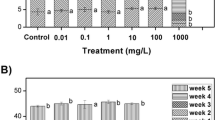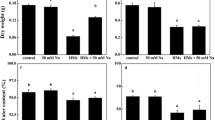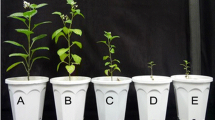Abstract
Kosteletzkya virginica is a wetland halophyte that is a good candidate for rehabilitation of degraded salt marshes and production of oil as biodiesel. Salt marshes are frequently contaminated by heavy metals. The distribution of Zn in vegetative and reproductive organs of adult plants, and the NaCl influence on this distribution remain unknown and were thus explored in the present study. Plants were cultivated in a nutrient film technique system, from seedling stage until seed maturation in a control, Zn (100 μM), NaCl (50 mM) or Zn + NaCl medium. Photosynthesis, ion nutrition, malondialdehyde and non-protein thiol concentrations were quantified. Zinc distribution in reproductive organs was estimated by a laser ablation-inductively coupled plasma-mass spectrometry procedure (LA-ICP-MS). Adult plants accumulated up to 2 mg g−1 DW Zn in the shoots. Zinc reduced plant growth, inhibited photosynthesis and reduced seed yield. Zinc accumulation in the seeds was only two times higher in Zn-treated plants than in controls. Exogenous NaCl neutralized the damaging action of Zn and modified the Zn distribution through a preferential accumulation of toxic ions in older leaves. Zinc was present in seed testa, endosperm and, to a lower extent, in embryo. Additional NaCl induced a chalazal retention of Zn during seed maturation and reduced final Zn seed content. It is concluded that NaCl 50 mM had a positive impact on the response of K. virginica to Zn toxicity and acts through a modification in Zn distribution rather than a decrease in Zn absorption.






Similar content being viewed by others
Abbreviations
- A :
-
Net carbon assimilation rate
- BP:
-
Basal part of the plant
- E :
-
Instantaneous transpiration
- F 0 :
-
Minimal fluorescence level
- F m :
-
Maximal fluorescence level
- FP:
-
Mean number of flowers per plant
- g s :
-
Stomatal conductance
- LA-ICP-MS:
-
Laser ablation-inductively coupled plasma-mass spectrometry
- LN:
-
Number of leaves
- LR:
-
Mean length of the ramifications
- MDA:
-
Malondialdehyde
- NR:
-
Number of ramifications
- NFT:
-
Nutrient film technique
- NPQ:
-
Non-photochemical quenching
- PSII:
-
Photosystem II
- qP:
-
Photochemical quenching coefficient
- SL:
-
Mean length of the main stem
- UP:
-
Upper part of the plant
- ΦPSII:
-
Actual PSII efficiency
- Ψ w :
-
Leaf water potential
- Ψ s :
-
Osmotic potential
- WC:
-
Water content
References
Brüx A, Liu TY, Krebs M, Stierhof YD, Lohmann JU, Miersch O, Wasternack C, Schumaker K (2008) Reduced V-ATPase activity in the trans-Golgi network causes oxylipin-dependent hypocotyls growth inhibition in Arabidopsis. Plant Cell 14:1347–1357
Callender E, Rice KC (2000) The urban environmental gradient: anthropogenic influences on the spatial and temporal distributions of lead and zinc in sediments. Environ Sci Technol 34:232–238
Cambrollé J, Mancilla-Leytón JM, Muñoz-Vallés S, Luque T, Figueroa ME (2012) Zinc tolerance and accumulation in the salt-marsh shrub Halimione portulacoides. Chemosphere 86:867–874
Comino E, Whiting SN, Neumann PM, Baker AJM (2005) Salt (NaCl) tolerance in the Ni hyperaccumulator Alyssum murale and the Zn hyperaccumulator Thlaspi caerulescens. Plant Soil 270:91–99
Dafni A, Firmage D (2000) Pollen viability and longevity. Plant Syst Evol 222:113–132
Dafni A, Kevan PG, Husband BC (2005) Practical pollination biology. Enviroquest, Cambridge. p 590
De Vos CHR, Vonk MJ, Vooijs R, Schat H (1992) Glutathione depletion due to copper-induced phytochelatin synthesis causes oxidative stress in Silene cucubatus. Plant Physiol 98:853–858
Ernst WHO, Nelissen HJM (2000) Life-cycle phases of a zinc- and cadmium-resistant ecotype of Silene vulgaris in risk assessment of polymetallic mine soils. Environ Poll 107:329–338
Fukao Y, Ferjani A, Tomioka R, Nagasaki N, Kurata R, Nishimori Y, Fujiwara M, Maeshima M (2011) iTRAQ analysis reveals mechanisms of growth defects due to excess zinc in Arabidopsis. Plant Physiol 155:1893–1907
Ghanem ME, Han RM, Classen B, Mahy G, Quetin-Leclerq J, Ruan CJ, Qin P, Pérez-Alfocea F, Lutts S (2010) Mucilage and polysaccharides in the halophyte plant species Kosteletzkya virginica: localization and composition in relation to salt stress. J Plant Physiol 167:382–392
Gholap DS, Izmer A, De Samber B, van Elteren JT, ŠeSchamphelaere K, Janssen C, Balcaen L, Lindemann I, Vincze L, Vanhaecke F (2010) Comparison of laser ablation-inductively coupled plasma-mass spectrometry and micro-X-ray fluorescence spectrometry for elemental imaging in Daphnia magna. Anal Chim Acta 664:19–26
Han RM (2013) Sodium chloride improves heavy metal tolerance in the halophyte Kosteletzkya virginica independently of growth stimulation. PhD Thesis, Université catholique de Louvain, Belgium, p 310
Han RM, Lefèvre I, Ruan CJ, Qin P, Lutts S (2012a) NaCl differently interferes with Cd and Zn toxicities in the wetland halophyte species Kosteletzkya virginica (L.) Presl. Plant Growth Regul 68:97–109
Han RM, Lefèvre I, Ruan CJ, Beukelaers N, Qin P, Lutts S (2012b) Effects of salinity on the response of the wetland halophyte Kosteletzkya virginica (L.) Presl. to copper toxicity. Water Air Soil Poll 223:1137–1150
Han RM, Lefèvre I, Albacete A, Pérez-Alfocea FP, Barba-Espín G, Díaz-Vivancos P, Quinet M, Ruan CJ, Hernández JA, Cantero-Navarro E, Lutts S (2013) Antioxidant enzyme activities and hormonal status in response to Cd stress in the wetland halophyte Kosteletzkya virginica (L.) Presl. under saline conditions. Physiol Plant 147:352–368
He ZX, Ruan CJ, Qin P, Seliskar DM, Gallagher JL (2003) Kosteletzkya virginica, a halophytic species with potential for agrotechnology in Jiangsu Province, China. Ecol Eng 21:271–276
Heath RL, Packer L (1968) Photoperoxidation in isolated chloroplasts. I. Kinetics and stoichiometry of fatty acid peroxidation. Arch Biochem Biophys 125:189–198
Kholodova VP, Volkov KS, Kuznetson KLK (2005) Adaptation of the common ice plant to high copper and zinc concentrations and their potential using for phytoremediation. Russ J Plant Physiol 52:848–858
Lefèvre I, Marchal G, Meerts P, Corréal E, Lutts S (2009a) Chloride salinity reduces cadmium accumulation by the Mediterranean halophyte species Atriplex halimus L. Environ Exp Bot 65:142–152
Lefèvre I, Marchal G, Corréal E, Zanuzzi A, Lutts S (2009b) Variation in response to heavy metals during vegetative growth in Dorycnium pentaphyllum Scop. Plant Growth Regul 59:1–11
Lefèvre I, Corréal E, Lutts S (2010) Impact of cadmium and zinc on growth and water status of Zygophyllum fabago issued from two contrasting metallicolous populations from the SE Spain: comparison at the whole plant and tissue levels. Plant Biol 12:883–894
Li Q, Lau A, Morris TJ, Guo L, Fordyce CB, Stanley EF (2004) A syntaxin 1, Gαo, and N-type calcium channel complex at a presynaptic nerve terminal: analysis by quantitative immunocolocalization. J Neurosci 24:4070–4081
Lichtenthaler HK (1987) Chlorophylls and carotenoids: pigments of photosynthetic biomembranes. Methods Enzymol 148:350–382
Lin W, Xiao T, Wu Y, Ao Z, Ning Z (2012) Hyperaccumulation of zinc by Corydalis davidii in Zn-polluted soils. Chemosphere 86:837–842
López-Chucken UJ, Young SD (2005) Plant screening of halophyte species for cadmium phytoremediation. Zeitsch Naturforg 60:236–243
Lutts S, Bouharmont J, Kinet JM (1999) Physiological characterization of salt-resistant rice (Oryza sativa L.) somaclones. Aust J Bot 47:835–849
Lutts S, Lefèvre I, Delpérée C, Kivits S, Dechamps C, Robledo A, Correal E (2004) Heavy metal accumulation by the halophyte species Mediterranean saltbush. J Environ Qual 3:1271–1279
Mahon S, Carman KR (2008) The influence of salinity on the uptake, distribution, and excretion of metals by the smooth cordgrass, Spartina alterniflora (Loisel.), grown in sediment contaminated by multiple metals. Estuaries Coasts 31:1089–1097
Mateos-Naranjo E, Redonodo-Gómez S, Cambrollé J, Luque T, Fugeroa ME (2008) Growth and photosynthetic responses to zinc stress of an invasive cordgrass Spartina densiflora. Plant Biol 10:754–762
Maxwell K, Johnson GN (2000) Chlorophyll fluorescence—a practical guide. J Exp Bot 51:659–668
McFarlane GR, Burchett M (1999) Zinc distribution and excretion in the leaves of the grey mangrove, Avicenia marina (Forsk.) Vierh. Environ Exp Bot 41:167–175
Mesjasz-Przybylowicz J, Grodzińska K, Przybylowicz WJ, Godzik B, Szarek-Lukaszewska G (1999) Micro-PIXE studies of elemental distribution in seeds of Silene vulgaris from a zinc dump in Olkusz, southern Poland. Nucl Instr Meth Phys Res B158:306–311
Morillo J, Usero J, Gracia I (2004) Heavy metal distribution in marine sediments from the southwest coast of Spain. Chemosphere 55:431–442
Ohnishi N, Murata N (2006) Glycinebetaine counteracts the inhibitory effects of salt stress on the degradation and synthesis of the D1 protein during photo inhibition of Synechococus sp. PCC7942. Plant Physiol 141:758–765
Otte ML, Bestebroer SJ, van der Linden JM, Rozema J, Broekman RA (1991) A survey of zinc, copper and cadmium concentrations in salt marsh plants along the Dutch coast. Environ Poll 72:175–189
Ozturk L, Yazici MA, Yucel C, Torun A, Cekic C, Bagci A, Ozkan H, Braun HJ, Sayers Z, Cakmak I (2006) Concentration and localization of zinc during seed development and germination in wheat. Physiol Plant 128:144–152
Rai PK (2008) Heavy metal pollution in aquatic ecosystems and its phytoremediation using wetland plants: an ecosustainable approach. Intern J Phytorem 10:133–160
Reck B, Bertram M, Müller DB, Graedel TE (2006) Multilevel anthropogenic cycles of copper and zinc: a comparative statistical analysis. J Ind Ecol 10:89–110
Redondo-Gómez S, Andrades-Moreno L, Mateos-Naranjo E, Parra R, Valera-Burgos J, Aroca R (2011) Synergic effect of salinity and zinc stress on growth and photosynthetic responses of the cordgrass, Spartina densiflora. J Exp Bot 62:5521–5530
Ruan CJ, Li H, Guo YQ, Qin P, Gallagher JL, Seliskar DM, S Lutts, Mahy G (2008) Kosteletzkya virginica, an agroecoengineering halophytic species for alternative agriculture production in China’s east coast: ecological adaptation and benefits, seed yield, oil content, fatty acid and biodiesel properties. Ecol Eng 32:320–328
Ruan CJ, Teixeia da Silva JA, Mopper S, Qin P, Lutts S (2010) Halophyte improvement for a salinized world. Crit Rev Plant Sci 29:329–359
Ruan CJ, Xing WH, Teixeira da Silva JA (2012) Potential of five plants growing on unproductive agricultural lands as biodiesel resources. Renew Energy 41:191–199
Sáinz A, Grande JA, De la Torre ML, Sánchez-Rodas D (2002) Characterisation of sequential leachate discharge of mining waste rock dumps in the Tinto and Odiel rivers. J Environ Manag 64:345–353
Tauris B, Borg S, Gregersen PL, Holm PB (2009) A roadmap for zinc trafficking in the developing barley grain based on laser capture microdissection and gene expression profiling. J Exp Bot 60:1333–1347
Tewari RK, Kumar P, Sharma PN (2008) Morphology and physiology of zinc-stressed mulberry plants. J Plant Nutr Soil Sci 171:286–294
Vaillant N, Monnet F, Hitmi A, Sallanon H, Coudret A (2005) Comparative study of responses in four Datura species to zinc stress. Chemosphere 59:1005–1013
Vogel-Mikuš K, Pongrac P, Kump P, Nečemer M, Simčič J, Pelicon J, Budnar M, Povh B, Regvar M (2007) Localisation and quantification of elements within seeds of Cd/Zn hyperaccumulator Thlaspi praecox by micro-PIXE. Environ Poll 147:50–59
Wang YX, Specht A, Horst WJ (2011) Stable isotope labelling and zinc distribution in grains studied by laser ablation ICP-MS in an ear culture system reveals zinc transport barriers during grain filling in wheat. New Phytol 189:428–437
Weis JS, Weis P (2004) Metal uptake, transport and release by wetland plants: implications for phytoremediation and restoration. Environ Int 30:687–700
Whiting SN, Neumann PM, Baker AJM (2003) Nickel and zinc hyperaccumulation by Alyssum murale and Thlaspi caerulescence (Brassicaceae) do not enhance survival and whole-plant growth under drought stress. Plant, Cell Environ 26:351–360
Wirth J, Poletti S, Aeshlimann B, Yakandawala B, Drosse B, Osorio S, Tohge T, Fernie AR, Günther D, Gruissem W et al (2009) Rice endosperm iron biofortification by targeted and synergistic action of nicotianamine synthase and ferritin. Plant Biotech J 7:631–644
Acknowledgments
This work was supported by the Belgian Science Policy (BELSPO): Chinese-Belgian Cooperation Project [200441505], by the Fonds National de la Recherche Scientifique (Crédit aux Chercheurs—Conventions no 1.5.111.10F, 1.5117.11), and by Wallonie-Bruxelles-International (Convention mixte: WBI—République de Slovénie). R.-M. Han is grateful to the Université catholique de Louvain (UCL) for the award of a research fellowship. The authors are grateful to Mr B. Capelle and Mrs B. Van Pee for their precious technical assistance.
Author information
Authors and Affiliations
Corresponding author
Electronic supplementary material
Below is the link to the electronic supplementary material.
Rights and permissions
About this article
Cite this article
Han, R., Quinet, M., André, E. et al. Accumulation and distribution of Zn in the shoots and reproductive structures of the halophyte plant species Kosteletzkya virginica as a function of salinity. Planta 238, 441–457 (2013). https://doi.org/10.1007/s00425-013-1903-3
Received:
Accepted:
Published:
Issue Date:
DOI: https://doi.org/10.1007/s00425-013-1903-3




